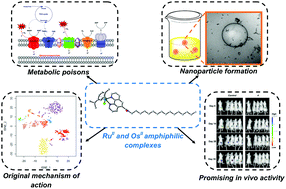Self-assembled ruthenium and osmium nanosystems display a potent anticancer profile by interfering with metabolic activity†
Abstract
We disclose novel amphiphilic ruthenium and osmium complexes that auto-assemble into nanomedicines with potent antiproliferative activity by inhibition of mitochondrial respiration. The self-assembling units were rationally designed from the [M(p-cymene)(1,10-phenanthroline)Cl]PF6 motif (where M is either RuII or OsII) with an appended C16 fatty chain to achieve high cellular activity, nano-assembling and mitochondrial targeting. These amphiphilic complexes block cell proliferation at the sub-micromolar range and are particularly potent towards glioblastoma neurospheres made from patient-derived cancer stem cells. A subcutaneous mouse model using these glioblastoma stem cells highlights one of our C16 OsII nanomedicines as highly successful in vivo. Mechanistically, we show that they act as metabolic poisons, strongly impairing mitochondrial respiration, corroborated by morphological changes and damage to the mitochondria. A genetic strategy based on RNAi gave further insight on the potential involvement of microtubules as part of the induced cell death. In parallel, we examined the structural properties of these new amphiphilic metal-based constructs, their reactivity and mechanism.



 Please wait while we load your content...
Please wait while we load your content...